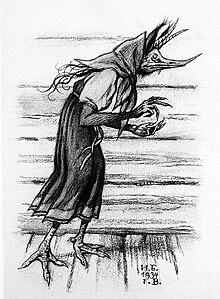Kikimora

The Kikimora ( Russian кикимора, шишимора : "Kikímora, Schischímora"); मार is the image of an old pagan deity that was rededicated to a poltergeist after the Christianization of the Slavs and Ugrians . It occurs in both the East and West Slavic pantheons - among Russians, Poles and Czechs, Ugrians - and has analogues also among the South Slavs.
According to some Russian authors, the origin of the Kikimora is considered to be the female, East Slavic deity Mokosch (Russian Макошь , Мокошь ), an originally chthonic deity (earth deity) with clear parallels to other goddesses of the Indo-European pantheon. On the other hand, the Kikimora combines features that also make an independent origin appear possible. There are also descriptions of a Kikimora on the English-language Internet , although it is not always clear, due to a lack of sources, whether these go back to originally Anglo-Saxon mythological ideas or - what is more likely - have been adopted from the Slavic language area.
The Kikimora that occurs among the Slavs as old, strangely dressed, mostly invisible woman in appearance, is accused of, among other things, that it spins strands where they domestic distaff disheveled and messes, and that it rumbles while trying the inhabitants of a House crazy with noises until they leave the house. It brings bad luck to those who see it - it is not uncommon for such an incident to end with the death of a resident. But it also steals domestic fowl or prevents it from laying eggs. Popular belief says that in order to ward off the evil influence, one should hang the severed neck of a jug or a stone with a natural hole above the nests or in front of the stables. This was also included in the dictionary of the Greater Russian language by Vladimir Dal, which was created in the 19th century . This explains the term chicken god .
Occasionally, Kikimora and Mara (see below) were identified with one another. Conversely, the Kikimora has sometimes also been interpreted by the Russians as the wife of the household, the Domowoi . Not only in houses, but also in swamps, Kikimoras are said to have occurred, which in some traditions were said to have werewolf-like properties. The word Kuriny bog (Russian куриный бог; chicken god ) in turn denotes not only perforated stones in the Slavic language area, but also other objects used as talismans against the Kikimora - such as vessels with a knocked-out bottom or old things, for example worn bast shoes that are just like Perforated bricks were used.
For the time being, the question must remain speculative as to whether the second part of the name of the house spirit Kikimora , as D. Zelenin suspected and considered very likely by modern Russian authors, is etymologically linked to the same root that is found in the German Mahr or Nachtmar ( Nachtmahr ), the English Nightmare or the French Cauchemar (e) (everything in the sense of nightmare ). Some German internet sources also claim that the name Mahr (such as Thrud , Toggeli , Schrat and Walrider ) is a synonym for Alb ( Alp ). The original designation of the three Greek goddesses of fate - Moiren (Sing. Moira ), which correspond to the Roman Parzen and the related Germanic Norns - seems to point in this direction, similar to the root * mor - for darkness, gloom, which is also found in many Indo-European languages or death. Similar figures, the so-called Mira, also appear in the Albanian pantheon . All this suggests that the ideas of the kikimora and of perforated stones used as talismans are of a great age and probably already developed with the religious ideas of the ancient Indo-Europeans. In ancient Greek mythology, for example, there was originally only one moira , whose attributes (such as the spinning, measuring and cutting of threads of life or fate, which was then ascribed to the moiras of Klotho , Lachesis and Atropos ) show parallels to those of the Kikimora . It fits that, for example, in East and South Slavic mythology there were originally fatal female figures with the designation Mora , Mara (Russian: мара ), Morena and others who are linked to fateful encounters. The figure of Morgan le Fay , who comes from Celtic mythology and who later entered the circle of legends about King Arthur as a healer but also as a resident of the Otherworld , seems to be related to these ideas (cf.Literature, but also those below Mara listed references to mythological figures or deities of other peoples).
The Russian composer Anatoly Lyadow (1855–1914) portrayed Kikimora in his symphonic poem of the same name in 1905 , op 63. The figure of Kikimora has also found its way into Russian literature on various occasions , for example in the stories of the same name by Albert Lichanow , Ludmila Milewskaja or Orest Somow .
literature
- Dmitrij Zelenin : Russian (East Slavic) folklore. (Outline of Slavic philology and cultural history . Ed. By Reinhold Trautmann and Max Vasmer ). Berlin and Leipzig, Walter de Gruyter 1927.
Individual evidence
- ↑ Vladimir Dal : Кикимора . In: Толковый словарь живого великорусского языка. 1881. (Russian)